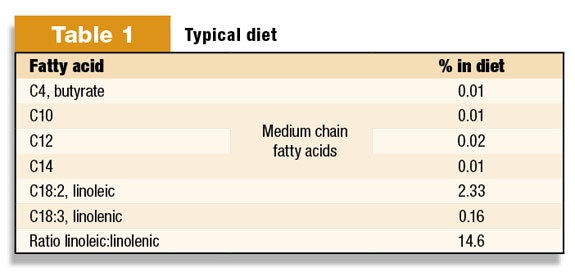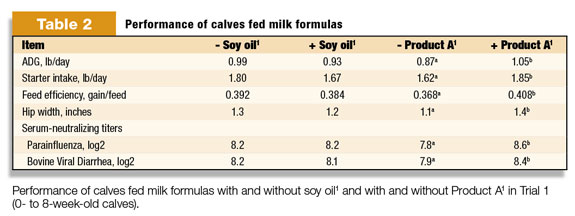Dairy calf feeds are normally low in functional fatty acids (butyric acid, medium-chain fatty acids, and linolenic acid – see Table 1) known to influence metabolism and immunity – and calves respond to their supplementation. Additionally, calf feeds are normally high in linoleic acid and, if it is increased in the diet, calf performance is often decreased.
Why are calf diets low in butyric acid, medium-chain fatty acids and linolenic acid? Dry feeds fed to livestock in the U.S. typically are made from corn, oats, barley, wheat, soybeans and their co-products (i.e. distillers grains, wheat midds, soybean meal).

These plants do not store butyric acid, medium-chain fatty acids or much linolenic acid. They do store linoleic acid. Fat from pigs and cattle are used to make milk formulas. Pigs and cattle do not store short-chain (butyric) acids and medium-chain fatty acids in their fat, but their fat reflects the longer fatty acids profile of their diet. Therefore, animal fat will be high in linoleic acid.
Butyric and linolenic acids are anti-inflammatory fatty acids that are involved in the immune system. Medium-chain fatty acids have synergistic roles in metabolism with linolenic acid, as well as having anti-microbial and anti-viral properties.
In controlled and published research with a commercial source of these fatty acids supplemented to calf milk formulas, starters and grower feeds, sickness in calves was reduced and growth of the calves was significantly increased.
Additionally, several markers of immunity (globulins produced in response to pasteurella vaccines and salmonella toxoids, titers to parainfluenza and bovine viral diarrhea vaccination, and cytokines) were improved. In one trial, these improvements in immune markers were measured after feeding the fatty acids for only six days.
Linoleic acid is an Omega-6 (inflammatory) fatty acid. Linolenic acid is an Omega-3 (anti-inflammatory) fatty acid. These fatty acids are frequently manipulated in human diets due to their implication to human health. The optimum ratio of linoleic-to-linolenic acid is less than 10-to-1.
However, the typical calf diet is much greater than 10-to-1 (see Table 1). Because the Omega-6 fatty acids are coming from the basal ingredients, supplementing calf diets with linolenic acid is the way to correct this ratio.
Here are some examples of the effects on calf health and performance from expert reviewed and published research. A 2011 article in the Professional Animal Scientist reported the results of three trials where adding soy oil (high in linoleic acid) either tended to reduce or reduced bodyweight gain and change in hip width of calves when added to the milk formula, starter and grower diets.

(See Tables 2, 3 , and 4 for results.) The formula, starters and growers were based on typical ingredients used in U.S. diets (animal fat, corn and soybean meal) which are naturally high in linoleic acid.
Adding more linoleic acid via soy oil was negative. Additionally, the fever response to a pasteurella vaccine was increased from adding soy oil, demonstrating its well-understood effect to increase inflammation.
Conversely, adding a combination of butyric acid, medium-chain fatty acids and linolenic acid (using a commercial product) increased bodyweight gain and change in hip width in each trial.

Additionally, adding this combination of fatty acids to the formula reduced the fever to the pasteurella vaccine and increased titers to both a parainfluenza vaccine and a bovine viral diarrhea vaccine.
A 2010 article in the Journal of Dairy Science reported greater secretion of digestive enzymes from the pancreas and greater digestion of the diet consumed by calves when butyric acid was supplemented.
A 2011 article in the same journal reported that supplementing butyric acid increased the development of the small intestine and rumen of calves.
Practically, on farms, there are some opportunities to improve the fatty acid profile of calf diets. Minimize or avoid the fat and oil addition to calf starters and growers.

This typically lowers the cost of a feed. Minimize or avoid using high fat and oil ingredients like soybeans and distillers grains. These options will help to minimize the linoleic acid content of the diet.
Supplement commercial sources of butyric acid, medium-chain fatty acids, and linolenic acid to milk or milk formulas, starters and grower feeds. The cost is less than $1 per bag to milk formulas and less than $15 per ton to starters and growers.
This calculates to less than $1 per calf when supplemented to the milk formula or the starter feed. Correcting the fatty acid concentrations of the calf diets in these ways reduce the costs associated with health issues, lowers the cost of bodyweight gain and improves calf productivity.
In summary, traditional feeds for calves in North America tend to be high in the linoleic acid and deficient in functional fatty acids such as butyrate, medium-chain fatty acids and linolenic acid.
Supplementing these diets with commercial sources of these fatty acids has been shown in published research to improve markers of calf health. This in turn has resulted in improvements to calf growth. This supplementation can be done for relatively low cost and can improve returns in the calf-growing enterprise on many dairy farms. PD
Gale Bateman, Ph.D., is also from the Nurture Research Center of Provimi North America, Inc.
References omitted due to space but are available upon request. Click here to email an editor.

-
Mark Hill Ph.D.
- Nurture Research Center
- Provimi North America Inc.
- Email Mark Hill Ph.D.







